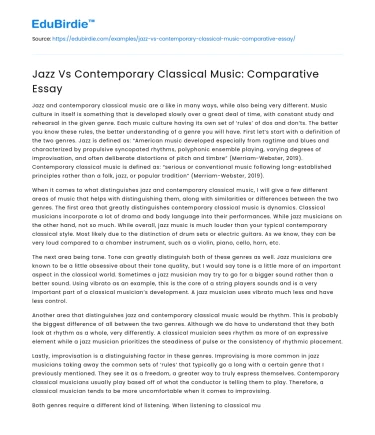Jazz and contemporary classical music are a like in many ways, while also being very different. Music culture in itself is something that is developed slowly over a great deal of time, with constant study and rehearsal in the given genre. Each music culture having its own set of ‘rules’ of dos and don’ts. The better you know these rules, the better understanding of a genre you will have. First let’s start with a definition of the two genres. Jazz is defined as: “American music developed especially from ragtime and blues and characterized by propulsive syncopated rhythms, polyphonic ensemble playing, varying degrees of improvisation, and often deliberate distortions of pitch and timbre” (Merriam-Webster, 2019). Contemporary classical music is defined as: “serious or conventional music following long-established principles rather than a folk, jazz, or popular tradition” (Merriam-Webster, 2019).
When it comes to what distinguishes jazz and contemporary classical music, I will give a few different areas of music that helps with distinguishing them, along with similarities or differences between the two genres. The first area that greatly distinguishes contemporary classical music is dynamics. Classical musicians incorporate a lot of drama and body language into their performances. While jazz musicians on the other hand, not so much. While overall, jazz music is much louder than your typical contemporary classical style. Most likely due to the distinction of drum sets or electric guitars. As we know, they can be very loud compared to a chamber instrument, such as a violin, piano, cello, horn, etc.
Save your time!
We can take care of your essay
- Proper editing and formatting
- Free revision, title page, and bibliography
- Flexible prices and money-back guarantee
The next area being tone. Tone can greatly distinguish both of these genres as well. Jazz musicians are known to be a little obsessive about their tone quality, but I would say tone is a little more of an important aspect in the classical world. Sometimes a jazz musician may try to go for a bigger sound rather than a better sound. Using vibrato as an example, this is the core of a string players sounds and is a very important part of a classical musician’s development. A jazz musician uses vibrato much less and have less control.
Another area that distinguishes jazz and contemporary classical music would be rhythm. This is probably the biggest difference of all between the two genres. Although we do have to understand that they both look at rhythm as a whole, very differently. A classical musician sees rhythm as more of an expressive element while a jazz musician prioritizes the steadiness of pulse or the consistency of rhythmic placement.
Lastly, improvisation is a distinguishing factor in these genres. Improvising is more common in jazz musicians taking away the common sets of ‘rules’ that typically go a long with a certain genre that I previously mentioned. They see it as a freedom, a greater way to truly express themselves. Contemporary classical musicians usually play based off of what the conductor is telling them to play. Therefore, a classical musician tends to be more uncomfortable when it comes to improvising.
Both genres require a different kind of listening. When listening to classical musicians play, it helps to be more educated in music to truly appreciate what they are playing. Jazz oftentimes has vocalists in addition to their instruments, while there is no vocalist in classical music. Jazz in a kind of music that is lot easier to groove to even if you do not fully understand music as a whole. I personally find it very difficult to listen to classical music versus jazz because it is very difficult to pay attention to, mainly because there are no vocals and it played at a much slower pace usually. While at the same time, jazz musicians use a lot of repetition which can also be a little difficult to listen to at times. Listening to the same thing over and over can easily lose attention as well.
In conclusion, the easiest ways to distinguish jazz and contemporary classical music are the four main areas: tone, rhythm, dynamics, and improvisation. But is important to keep in mind that the each require different training and different listening. While jazz is more upbeat and easier to be understood by the average ear, classical music is slower and more by the page. Altogether they are both amazing genres that have been successful for many years and standout in their own ways.
Works Cited
- Martin, H., & Waters, K. (2016). Jazz, The First 100 years. Massachusetts: Cengage Learning.
- Merriam-Webster. (2019, April 29). Merriam-Webster. Since 1828. Retrieved from https://www.merriam-webster.com/dictionary/jazz
- Zimmerli, P. (2016, December 15). New Music USA. Retrieved from New Music Box: https://nmbx.newmusicusa.org/jazz-and-classical-musical-cultural-listening-differences/






 Stuck on your essay?
Stuck on your essay?

